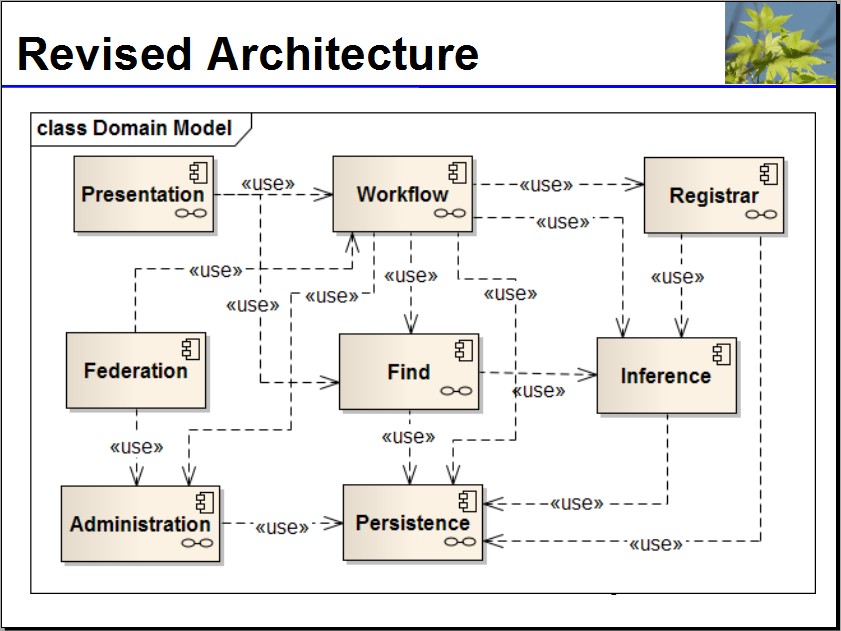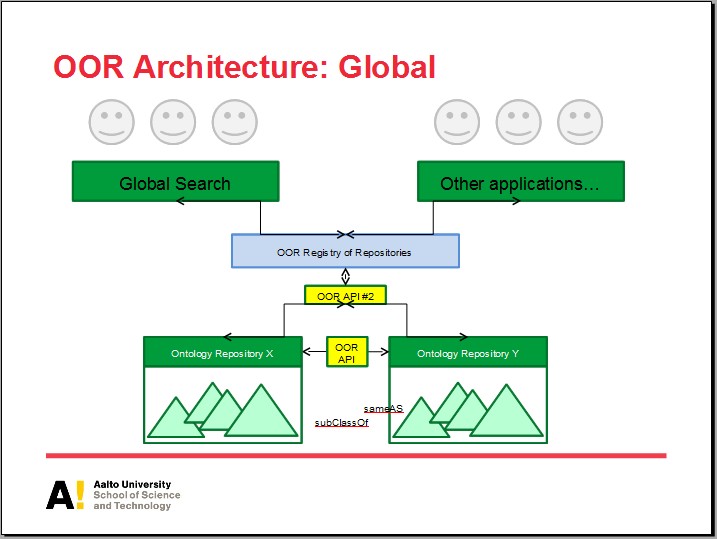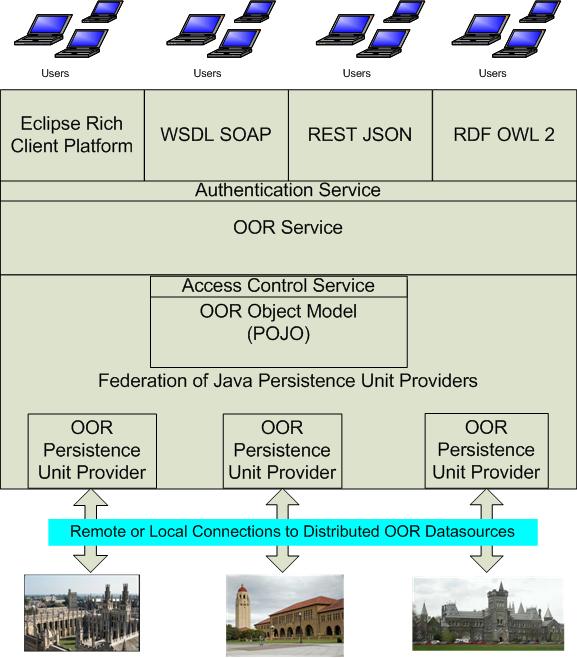OpenOntologyRepository: OOR Team Conference Call - Fri 2010-11-19 (2JLK)
Session Title: "(Post-BioPortal fork) OOR Architecture and API panel session - Take-II" (2JS8)
Session Co-chairs: KenBaclawski (NEU) & MichaelGruninger (U of Toronto) (2JS9)
Panelists: (2JSA)
- KenBaclawski (NEU) + ToddSchneider (Raytheon) (2JSB)
- AldoGangemi + AlessandroAdamou (STLab, Rome, Italy) (2JSC)
- JouniTuominen + KimViljanen (Aalto U, Finland) (2JSD)
- EricChan (ICOM) (2JSF)
... Please refer also to the notes from the last regular meeting at: OOR/ConferenceCall 2010_10_01 and the three recent pertinent sessions: (2JQK)
- "CL support for OOR" - ConferenceCall_2010_09_10 (2JQL)
- the "Fork" session - OOR/ConferenceCall_2010_09_17 (2JQM)
- the "post-fork" OOR Architecture and API discussion (Take-1) - OOR/ConferenceCall_2010_10_15 (2JQN)
Archives: (2JSG)
- Agenda & Proceedings (2JSH)
- Prepared presentation material can be accessed by clicking on each of the title links below: (2JVA)
- [ 0-chair ] . [ 1-Schneider-Baclawski ] . [ 2-Gangemi-Adamou ] . [ 3-Tuominen-Viljanen ] . [ 4-Chan ] (2JSJ)
- audio recording of the session [ mp3 ; 1:50:54 ; 12.69 MB ] (2JSK)
- Transcript of the online chat session during the panel discussion (2JSL)
- Other Resources (2JSM)
Conference Call Details: (2JPC)
- Date: Friday, 19-Nov-2010 (2JPD)
- Start Time: 6:00am PST / 9:00am EST / 2:00pm GMT / 3:00pm CET / 14:00 UTC (2JPE)
- ref: World Clock (2JPF)
- Expected Call Duration: ~2.0 hours (2JPG)
- Dial-in Number: (2JPH)
- Shared-screen support (VNC session), if applicable, will be started 5 minutes before the call at: http://vnc2.cim3.net:5800/ (2JSN)
- view-only password: "ontolog" (2JSO)
- if you plan to be logging into this shared-screen option (which the speaker may be navigating), and you are not familiar with the process, please try to call in 5 minutes before the start of the session so that we can work out the connection logistics. Help on this will generally not be available once the presentation starts. (2JSP)
- people behind corporate firewalls may have difficulty accessing this. If that is the case, please download the slides above (associated with the respective agenda item) and running them locally. The speaker(s) will prompt you to advance the slides during the talk. (2JSQ)
- Discussion, Questions & Remarks: (2JPV)
- (Unless the conference host has already muted everyone) Please mute your phone, by pressing "*2" on your phone keypad, when a presentation is in progress. To un-mute, press "*3" (2JSR)
- You can type in your questions or comments through the browser based chat session by: (2JSS)
- pointing a separate browser tab (or window) to http://webconf.soaphub.org/conf/room and enter: Room="oor_20101119" and My Name="Your Own Name" (e.g. "JaneDoe") (2JST)
- or point your browser to: http://webconf.soaphub.org/conf/room/oor_20101119 (2JSU)
- instructions: once you got access to the page, click on the "settings" button, and identify yourself (by modifying the Name field). You can indicate that you want to ask a question verbally by clicking on the "hand" button, and wait for the moderator to call on you; or, type and send your question into the chat window at the bottom of the screen. (2JSV)
- (when everyone is muted) If you want to speak or have questions or remarks to make, 'please "raise your hand (virtually)" by click on the "hand button" (lower right) on the chat session page. You may speak when acknowledged by the speaker or the session moderator (again, press "*3" on your phone to unmute). Test your voice and introduce yourself first before proceeding with your remarks, please.'' (Please remember to click on the "hand button" again (to lower your hand) and press "*2" on your phone to mute yourself after you are done speaking.) (2JSW)
- thanks to the soaphub.org folks, one can now use a jabber/xmpp client (e.g. gtalk) to join this chatroom. Just add the room as a buddy - (in our case here) oor_20101119@soaphub.org ... Handy for mobile devices! (2JSX)
- For those who cannot join us, or who have further questions or remarks on the summit topic and content, please post them to the [ oor-forum ] listserv so that everyone in the community can benefit from the discourse. (2JSY)
- Please review our Virtual Session Tips and Ground Rules - see: VirtualSpeakerSessionTips (2JSZ)
- RSVP to peter.yim@cim3.com appreciated, ... or simply just by adding yourself to the "Expected Attendee" list below (if you are a member of the team.) (2JPW)
- This session, like all other Ontolog events, is open to the public. Information relating to this session is shared on this wiki page: http://ontolog.cim3.net/cgi-bin/wiki.pl?OOR/ConferenceCall_2010_11_19 (2JPX)
- Please note that this session may be recorded, and if so, the audio archive is expected to be made available as open content, along with the proceedings of the call to our community membership and the public at-large under our prevailing open IPR policy. (2JPY)
Attendees (2JPZ)
- Attended: (2JQ0)
- KenBaclawski (2JQ3)
- MichaelGruninger (2JQ4)
- ToddSchneider (2JQ9)
- JouniTuominen (2JQC)
- KimViljanen (2JQD)
- MikeDean (2JQG)
- PeterYim (2JQ2)
- YefimZhuk (2JQO)
- LeoObrst (2JQH)
- AldoGangemi (2JQA)
- ImmanuelNormann (2JV2)
- MyCoyne (2JQX)
- YuriyMilov (2JQJ)
- BartGajderowicz (2JS7)
- MikeBennett (will join late) (2JR1)
- MattHettinger (2JV3)
- Expecting: (2JQ1)
- AlessandroAdamou (traveling, may join late) (2JQB)
- MathieuDaquin (2JQE)
- AlexGarcia (2JQI)
- StuartTurner (2JQW)
- BernardUlozas (2JR0)
- (2JQ5)
- ... if you are coming to the meeting, please add your name above (plus your affiliation, if you aren't already a member of the community) above, or e-mail <peter.yim@cim3.com> so that we can reserve enough resources to support everyone's participation. ... (2JQ6)
- Regrets: (2JQ7)
Resources: (2JT0)
- Please refer also to the notes from the last regular meeting at: OOR/ConferenceCall 2010_10_29 and the three recent pertinent sessions: (2JQK)
- "CL support for OOR" - ConferenceCall_2010_09_10 (2JQL)
- the "Fork" session - OOR/ConferenceCall_2010_09_17 (2JQM)
- the "post-fork" OOR Architecture and API discussion (Take-1) - OOR/ConferenceCall_2010_10_15 (2JQN)
- OOR homepage - http://OpenOntologyRepository.org (2JT1)
- OntologySummit2008_Communique (2JT2)
- the OOR-sandbox - http://oor-01.cim3.net/ontologies (2JT3)
- see also OOR_SandBox (2JT4)
- (upcoming!) OOR code repository - http://semwebcentral.org/projects/oor (2JT5)
- Pertient recent panel discussions: (2JT6)
- "CL support for OOR" proceedings - ConferenceCall_2010_09_10 (2JT7)
- "OOR-dev Take-4," the "Fork" session proceedings - OOR/ConferenceCall_2010_09_17 (2JT8)
- "OOR Use Cases Take-3" proceedings (with NEU discussion on gatekeeping) - ConferenceCall_2010_04_01 (2JT9)
- developing OOR work pages: (2JTA)
Agenda & Proceedings (2JQ8)
Session Topic: "Getting OOR Development Going - Take-IV" (2JLN)
- Session Format & Agenda: this is a virtual session conducted over an augmented conference call: (2JTF)
- 1. Opening - co-chairs ... slides (2JTG)
- 2. Panelists presentations - KenBaclawski+ToddSchneider, AldoGangemi+AlessandroAdamou, JouniTuominen+KimViljanen, MathieuDaquin, EricChan (~10 min. each) (2JTH)
- 3. Q & A and open discussion - All (30 min.) ... please refer to process above (2JTI)
- 4. Conclusion / Follow-up - co-chairs (2JTJ)
Abstracts: (2JTK)
we have decided to organize a second panel session: "(Post-BioPortal fork) OOR Architecture and API - Take-II" to continue discussion on the (post-BioPortal fork) OOR Architecture and API, and explore more proposals and options. In particular, we want, especially, to hear from those who are planning to contribute code to OOR, but have not had a chance to present their work, and tell us what they plan to bring to the table, and have suggestions about the system architecture. (2JTM)
Panel Member Talks: (2JTN)
Abstract: ... Ken Baclawski's initial OOR decomposition is slightly revised and expanded to identify specific component interfaces. (2JTQ)
Abstract: KReS is a RESTful infrastructure for managing ontology networks with pluggable KR components. In this briefing, I will provide an overview of KReS and answer questions people may have. (2JTT)
Abstract: ... We propose an OOR architecture consisting of simple APIs, ontology repository implementations conforming to these APIs and a registry of these repositories. Together these components create an OOR network that can be used to build services utilizing content from different ontology repositories. The approach is based on an observation that there are different kinds of use cases, ontologies, ontology service providers, etc., and therefore it may not be possible to implement a single OOR server that addresses all possible needs. We suggest that the OOR initiative should focus on APIs and enabling an ecosystem of ontology repositories, not on doing everything by ourselves. Test suites and baseline implementations for APIs are needed for validating API implementations on different ontology repositories and testing the APIs. (2JTX)
Abstract: ... The Open Ontology Repository provides repository services for a wide range of ontological resources. The OOR architecture should provide spaces for discussion, creation, maintenance, and collaboration on those resources. That will require general content management repositories and collaboration services. Two OASIS TCs, namely Content Management Interoperability Services (CMIS) TC and OASIS Integrated Collaboration Object Model (ICOM) for Interoperable Collaboration Services TC, are defining standards to promote interoperability of content management repositories and collaboration services. CMIS v1.0 is an approved standard with an open source implementation provided by Apache Chemistry. (2JU3)
ICOM is a framework for integrating a broad range of domain models for collaboration. ICOM adopts the CMIS domain model for Folder, Document, Version Control, and Relationship. ICOM complements the content management domain with Community, User, Group, Role (directory domain of LDAP), Space (team workspace), Category (taxonomy), and Tag. ICOM extends the content management domain to represent Unified Message, Calendar, Task List, Address Book, Blog, Wiki, Forum, Conference, Presence, Social Network, and other collaboration artifacts. ICOM TC members are editing a draft of that standard and incubating a Java Persistence API (JPA) prototype framework. The ICOM POJO classes are portable to any JPA provider. It is appropriate to release the POJO classes independently of the JPA prototype framework under an appropriate open source library license. (2JUZ)
I will be providing an overview of the ICOM model and the JPA prototype framework to illustrate the value-add that ICOM can bring to the services of the Open Ontology Repository. (2JV0)
Transcript of the online chat during the session: (2JU4)
see raw transcript here. (2JU5)
(for better clarity, the version below is a re-organized and lightly edited chat-transcript.) Participants are welcome to make light edits to their own contributions as they see fit. (2JU6)
-- begin of chat session -- (2JU7)
PeterYim: Welcome to the OpenOntologyRepository: OOR Team Conference Call - Fri 2010-11-19 (2JU8)
Session Title: "(Post-BioPortal fork) OOR Architecture and API - Take-II" (2JXP)
Session Co-chairs: KenBaclawski (NEU) & MichaelGruninger (U of Toronto) (2JXQ)
Panelists: (2JXR)
* KenBaclawski (NEU) + ToddSchneider (Raytheon) * AldoGangemi + AlessandroAdamou (STLab, Rome) * JouniTuominen + KimViljanen (Aalto U, Finland) * MathieuDaquin (NeOn, Open University, UK) * EricChan (ICOM) (2JXS)
please refer to details on the session page at: http://ontolog.cim3.net/cgi-bin/wiki.pl?OOR/ConferenceCall_2010_11_19 (2JXT)
. (2JXU)
anonymous morphed into JouniTuominen (2JXV)
JouniTuominen: Peter: are you controlling the presentation slides in the shared vnc and the presenter tells everyone (including you) to advance on slides, or how does it work? (2JXW)
PeterYim: yes ... just tell me when to advance slides ... and call out the slide number as well (2JXX)
JouniTuominen: Peter: ok, thanks (2JXY)
anonymous morphed into MichaelGruninger (2JXZ)
anonymous1 morphed into MyCoyne (2JY0)
KimViljanen: hello (2JY1)
MyCoyne: Where would I be able to obtain the presentation? (2JY2)
MyCoyne: Does anyone has a problem with audio: the speaker voice is very faint (2JY3)
PeterYim: I can hear them ok ... Ken seems to be fading in and out a bit, though (2JY4)
KimViljanen: http://www.onki.fi (2JY5)
KimViljanen: LOOS (workshop in ESWC2009): http://www.slideshare.net/digikim/ores2010-linked-openontologyservices20100528slideshare (2JY6)
MyCoyne: Questions for LOOS: (1) does LOOS use any underline grid or enterprise service bus for its registration? (2) Is there any API allows for merging of ontologies? (3) is LOOS available for dowloading trials? (2JY7)
anonymous morphed into BartGajderowicz (2JY8)
PeterYim: very well thought through presentation, Jouni and Kim ... thank you! (2JY9)
KimViljanen: Peter: thanks for the positive feedback above (2JYA)
ToddSchneider: ONKI seems to provide more capabilities than envisioned by the OOR (2JYB)
KimViljanen: Todd: e.g.? (2JYC)
ToddSchneider: Annotation (2JYD)
KimViljanen: but the main question we wanted to present is: is the OOR application needed or the APIs to connect existing ontology repositories? (2JYE)
KimViljanen: ok, so we are now planning the OOR Architecture (global) _and_ the Architechture of the reference implementation (2JYF)
KenBaclawski: Yes, Kim, that is the idea. (2JYG)
ImmanuelNormann: @ONKIs: I like the openess in your proposal w.r.t. technical solutions like REST vs. SOAP, different programming languages, etc. But I get the impression that you are committed to OWL-ontologies only. How open are you w.r.t. to different ontology languages? (2JYH)
KimViljanen: Immanuel: our idea in LOOS was to support "simple" ontologies in the spirit of SKOS. that is, we think there are common features shared among different ontology languages such as concepts have labels (2JYI)
KimViljanen: Immanuel: and for example if the user is searching for "fish", the user can then continue using the specific ontology repository for ontology specific functionalities, which may be ontology language dependent, require inference etc (2JYJ)
ImmanuelNormann: as said before I like the openess w.r.t to technical means to implement an OOR. But at some point we need to specify some service APIs - and finally we have to commit to some format to define service APIs. One option would be WSDL. What is your opinion? (2JYK)
KimViljanen: I would support many: e.g. in ONKI we provide both a REST, Web Service and JavaScript API --- the last two automatically created from the same java classes (2JYL)
KimViljanen: (which mean WSDL can be used describing the APIs) (2JYM)
MyCoyne: Is ICOM a licensed product from Oracle? (2JYN)
PeterYim: ICOM is an OASIS Technical Committee (TC) ... it is being developed as an open standard (2JYO)
MyCoyne: Thanks, Peter. This is very helpful. (2JYP)
ImmanuelNormann: @Kim: REST, SOAP, Java, JavaScript, ..., are rather specific language specific solutions. I think it wouldn't make sense to specify e.g. one API in two or more languages. I was rather thinking about programming language independent spec like e.g. IDL is used at W3C for specifying the DOM model, or WSDL for web services or WADL for the REST world. So is WSDL your favourite? (2JYQ)
KimViljanen: @Immanuel: well... typically we have made so simple APIs that just writing them in a (free form) human readable document has been enough (2JYR)
KimViljanen: @Immanuel: btw, we forgot to say in our presentation that we were discussing whether OOR could initiate / produce a W3C recommendation of this OOR API issue, as a member contribution or something (not fully familiar with the W3C procedures on this) (2JYS)
PeterYim: @Kim - International standardization is definitely a medium to long term goal ... whether it is W3C or OASIS or ISO, as the SDO (standard development organization) infrastructure we should leverage would depend on other pragmatic factors (e.g. who is on the team, experience of the members with the particular SDO process, expedience, which approach can best help us reach our ultimate goals ... etc.) (2JYT)
anonymous morphed into MattHettinger (2JYU)
MikeBennett: Standardization of metadata about ontologies - agreed, very important. There are a number of common problems currently implemented in different ways by different ontologies. We could start by cataloguing these. Provenance is one such. (2JYV)
KimViljanen: could the first step for aligning the ontologies be that each of us provides a document on their APIs (I suppose everybody have a somekind of a document existing), to get an overview (2JYW)
ToddSchneider: Yes. I'd suggest placing the artifacts on the OOR Architecture Wikipage (2JYX)
ToddSchneider: If possible, UML models would be optimal. (2JYY)
KimViljanen: [on Ken's remark that BioPortal (on which the OOR sandbox is running now) features about 126 methods] (ONKI LOOS API has ca. 10-15 methods) (2JYZ)
KenBaclawski: Here is the suggestion for followup action items: 1. Post your artifacts on the OOR Architecture wikipage, 2. Review the artifacts on the wikipage, 3. Schedule a new meeting. (2JZ0)
KenBaclawski: Those who were not at the Take I architecture meeting should review that wikipage. (2JZ1)
PeterYim: that Architecture & API (take-1) meeting would be at: http://ontolog.cim3.net/cgi-bin/wiki.pl?OOR/ConferenceCall_2010_10_15 (2JZ2)
KenBaclawski: Everyone should create their own subpage of the architecture wikipage. (2JZ3)
KimViljanen: thanks for an inspiring meeting! (2JZ4)
YuriyMilov: Thanks for the great presentations (2JZ5)
PeterYim: nice session ... thank you! (2JZ6)
PeterYim: -- session ended: 8:06am PST -- (2JZ7)
-- end of chat session -- (2JU9)
Audio Recording of this Session (2JUA)
- To download the audio recording of the session, click here (2JUB)
- the playback of the audio files require the proper setup, and an MP3 compatible player on your computer. (2JUC)
- Conference Date and Time: 19-Nov-2010 6:08~8:06 am PST (2JUD)
- Duration of Recording: 1 Hour 51 Minutes (2JUE)
- Recording File Size: 12.7 MB (in mp3 format) (2JUF)
- suggestion: its best that you listen to the session while having the presentations opened in front of you. You'll be prompted to advance slides by the speaker. (2JUG)
- Take a look, also, at the rich body of knowledge that this community has built together, over the years, by going through the archives of noteworthy past Ontolog events. (References on how to subscribe to our podcast can also be found there.) (2JUH)
Proposed Architectural Approaches: (2JUI)
- KenBaclawski+ToddSchneider (NEU, OOR) (2JUJ)
- AldoGangemi+AlessandroAdamou (STLab) (2JUL)
- JouniTuominen+KimViljanen (Aalto U) (2JUN)
For the record ... (2JUT)
How To Join (while the session is in progress) (2JUU)
- 1. Dial in with a phone: http://ontolog.cim3.net/cgi-bin/wiki.pl?OOR/ConferenceCall_2010_11_19#nid2JPH (2JUV)
- 2. Open chat in a new browser window: http://webconf.soaphub.org/conf/room/oor_20101119 (2JUW)
- 3. Download presentations for each speaker here: http://ontolog.cim3.net/cgi-bin/wiki.pl?OOR/ConferenceCall_2010_11_19#nid2JSI (2JUX)
- or, 3.1 access our shared-screen vnc server, if you are not behind a corporate firewall (2JUY)



